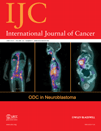The influence of a period of caloric restriction due to the Dutch famine on breast density
Abstract
Recently, we showed that short, intense caloric restriction due to the Dutch famine increased breast cancer risk in women and influenced the hormonal- and IGF-system. These systems may also affect breast density, which is one of the strongest risk factors for breast cancer. We examined the influence of the Dutch famine on breast density, using mammograms of 1,035 women. Breast size, dense and non-dense tissue and the relative density were measured on a continuous scale. Mean density was compared between three groups of ascending levels of famine-exposure. Results were adjusted for known determinants of breast density and stratified by age at exposure. There were no overall, significant differences by exposure. In unexposed compared to severely exposed women, means varied from 124 cm2 to 121 cm2 (ptrend = 0.50) for breast size, from 23.4 to 21.8 cm2 (ptrend = 0.48) for amount of dense tissue, from 87.7 to 85.4 cm2 (ptrend = 0.55) for non-dense tissue and from 22.8 to 22.3% (ptrend = 0.78) for relative density. Only among women who were younger than 10 years during the famine was the amount of non-dense tissue significantly lower with higher exposure, with 53.1 cm2 for severely exposed compared to 77.8 cm2 (ptrend = 0.03) for unexposed. This group also appeared to have smaller breasts with more absolute and relative density, but not statistically significant. We observed no overall effect on breast density in women severely exposed to a short, intense caloric restriction. However, in women exposed before puberty, the non-dense area was smaller and density tended to be higher.




